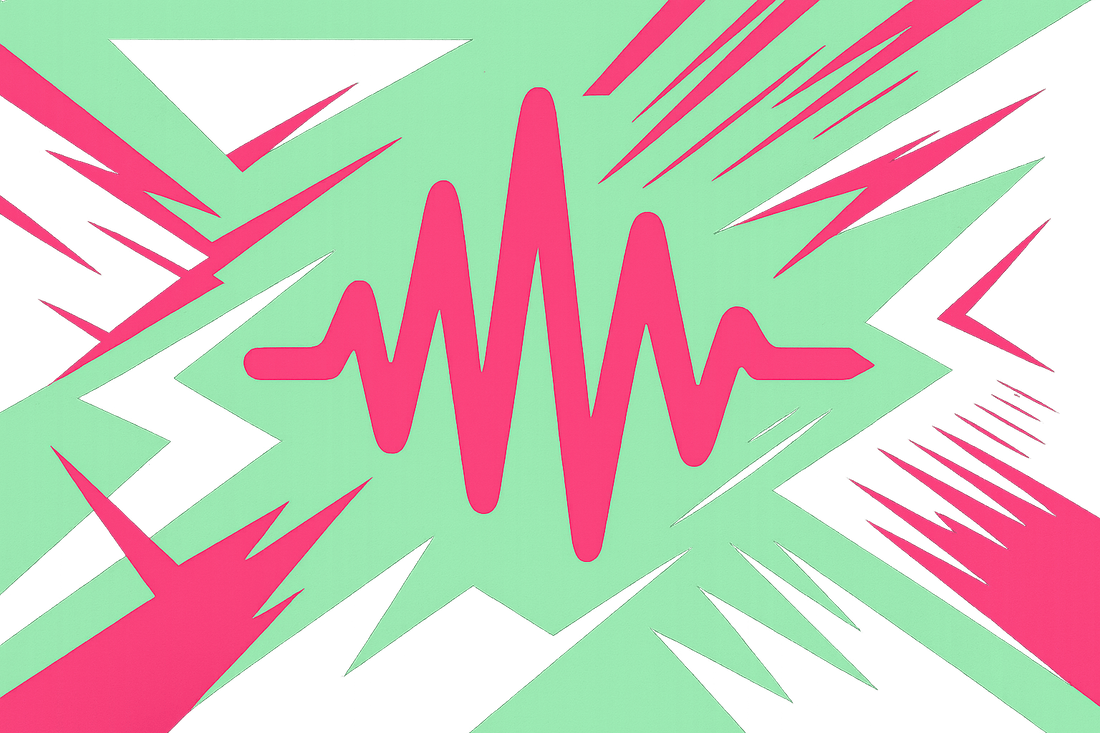
10 Clubs with Iconic Sound Systems
Dance music isn't just about the beats or the DJs - it’s about the sound systems that bring the music to life. From legendary venues like Berghain in Berlin to Fabric in London, these clubs have mastered the art of sound, transforming spaces into immersive audio experiences. Here's a quick look at what makes these venues stand out:
- Berghain (Berlin): Renowned Funktion-One system with precise tuning for its cavernous space.
- Ministry of Sound (London): A £500,000 Martin Audio system with Dolby Atmos for 360° soundscapes.
- Fabric (London): Known for its BodyKinetic dance floor that lets you feel the bass.
- Lux Frágil (Lisbon): Carefully upgraded Funktion-One system for studio-quality sound.
- Stereo (Montreal): Pure analogue sound system delivering unmatched clarity.
- Output (New York): Funktion-One system designed for immersive sound in an industrial setting.
- Amnesia (Ibiza): KV2 Audio systems with ultra-low distortion and rich basslines.
- Sub Club (Glasgow): Features a Bodysonic dancefloor and Martin Audio Blackline system.
- Despacio (Travelling): A McIntosh-powered vinyl-only setup with seven towering speaker stacks.
- The Loft (New York): Custom-built system focused on pure, unfiltered sound.
These venues prioritise sound quality, ensuring every beat resonates perfectly. Whether it’s Berghain’s Funktion-One stacks or The Loft’s minimalist approach, each space has created a unique identity through its sound system. Let’s explore what makes them iconic.
Pioneer Pro Audio - Case Study - fabric room two
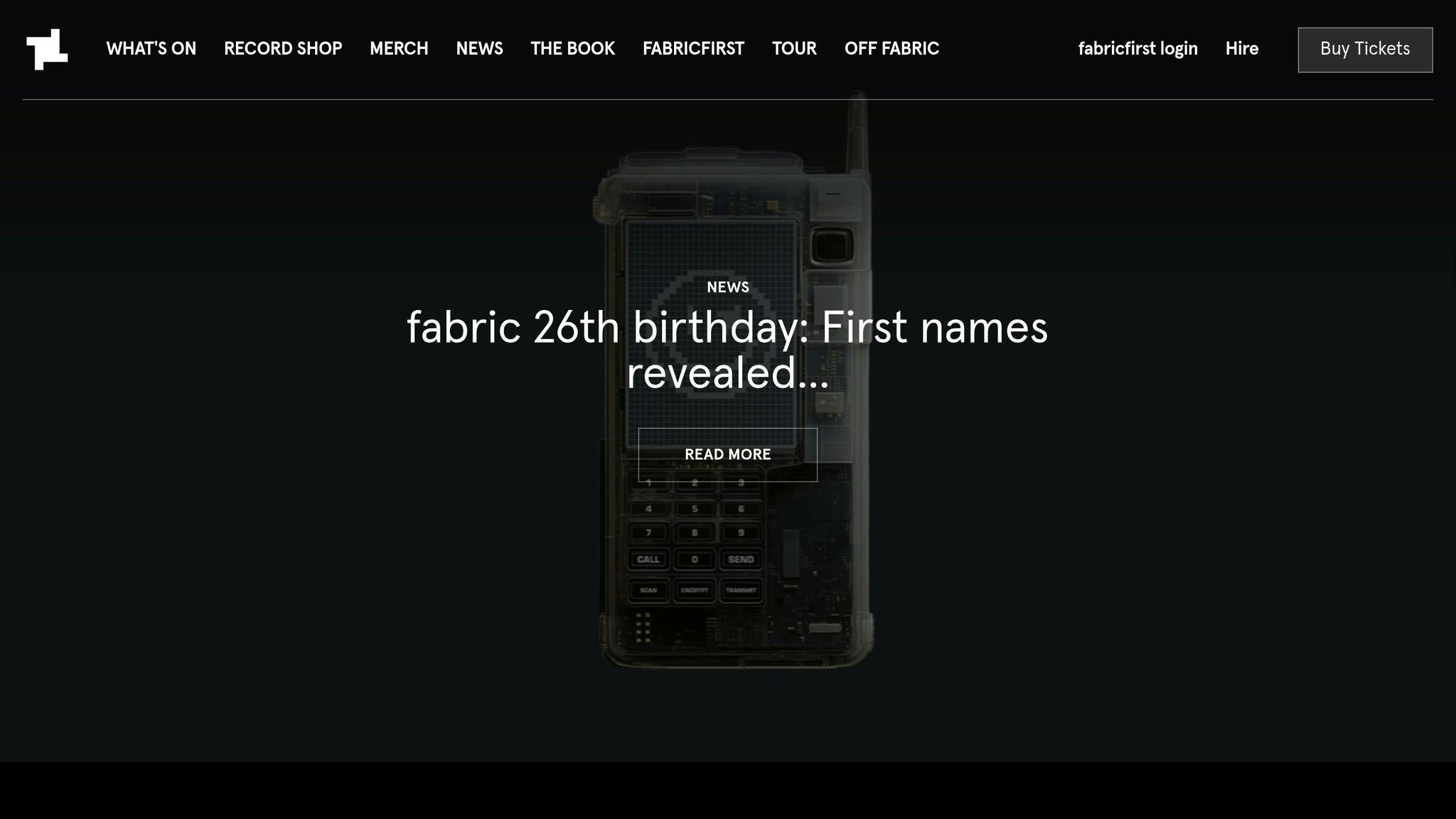
1. Berghain – Berlin, Germany
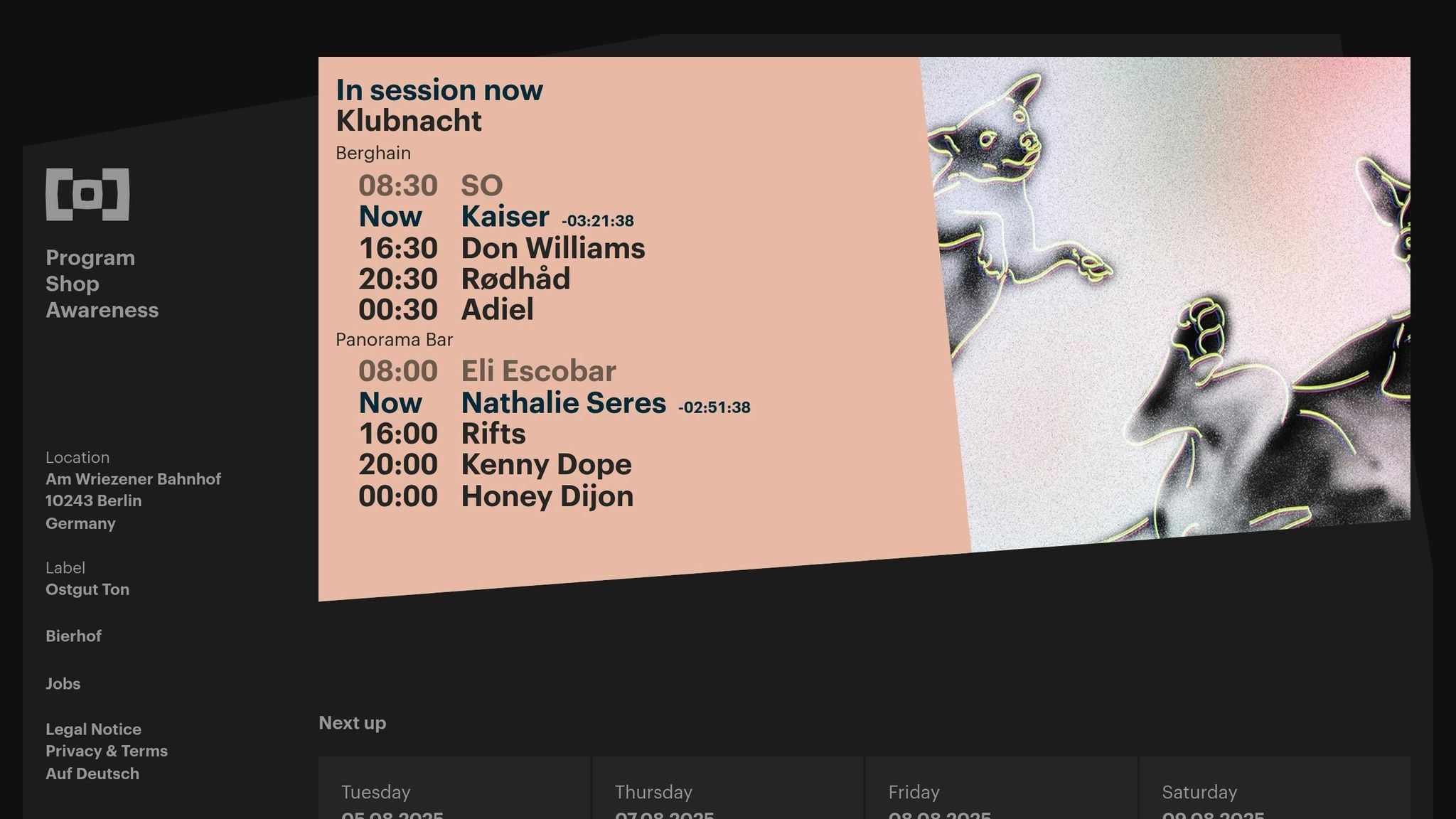
Berghain is often described as the ultimate techno sanctuary. Set within a former East German power plant, its imposing concrete walls and an 18-metre-high ceiling create a space that challenges traditional acoustics. These unique architectural features are part of what makes Berghain's sound system so exceptional, earning it a near-mythical status in the world of electronic music.
Sound System Brand and Technology
At the heart of Berghain's legendary sound is its Funktion-One system, originally installed by Tony Andrews in 2005. In 2023, the system underwent a major update, incorporating cutting-edge advancements in frequency response, accuracy, and stereo imaging to keep it at the forefront of audio technology.
"We utilised the very latest technology we have to offer and were blown away with the dimensional qualities the new system achieves. We hope to enjoy another 18 years of collaboration."
- Tony Andrews, Founder of Funktion-One
Acoustic Design and Customisation
Berghain's towering 18-metre ceiling presents unique acoustic challenges that required meticulous tuning from the start. Tony Andrews tailored the original Dance Stack to work seamlessly within the cavernous space, ensuring the sound remained both powerful and crystal clear. Over the years, the system has continued to evolve, with engineers and artists refining its performance to match the venue's demands.
Interestingly, Berghain's owners operate their sound system at just 10–20% of its total capacity. This approach ensures the energy is concentrated on the dancefloor, delivering an immersive experience without overwhelming the crowd. It's this attention to detail that cements Berghain's reputation as a mecca for dance music enthusiasts.
Impact on Dance Music Culture
Berghain's sound system is more than just a tool for amplification - it’s an integral part of the experience. The venue's famous "body-shifting bass cabinet" doesn’t just let you hear the music; it lets you feel it. This visceral connection between sound and movement has even influenced how some producers approach their music, creating tracks designed to resonate with Berghain's unique acoustics.
Key Innovations and Special Features
The 2023 upgrade to the Funktion-One system strikes a fine balance between modernisation and nostalgia. While some purists may miss the warm mids and thunderous bass of the original Dance Stack, the updated system offers a cleaner, more evenly distributed sound throughout the venue.
Berghain’s minimalist interior - dominated by steel and concrete - further enhances the auditory experience. The stark design ensures the music remains the central focus, creating an atmosphere where sound takes on a life of its own.
For those marathon clubbing sessions, even the smallest details matter. Dansu's premium quick-dry microfiber rave towels have become a must-have accessory, helping attendees stay cool and comfortable throughout Berghain’s famously long nights.
2. Ministry of Sound – London, UK
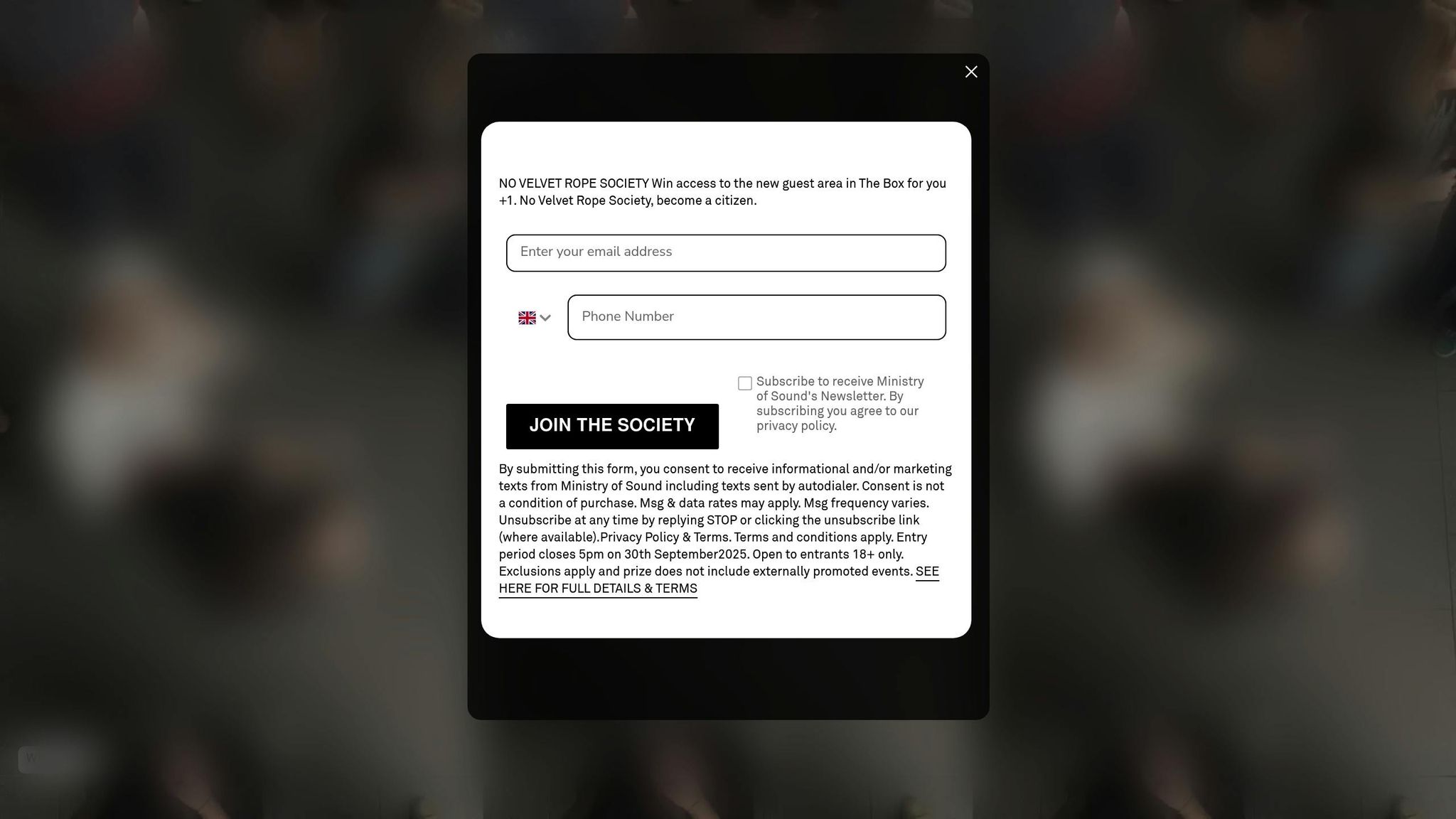
When Ministry of Sound opened its doors in 1991, it reshaped London's nightlife. What was once a bus garage in South London became the gold standard for modern superclubs. From the start, its mission was clear: deliver an unparalleled sound experience. This focus on audio excellence became the foundation for its many breakthroughs.
Sound System Brand and Technology
Ministry of Sound made an enormous investment of £500,000 in its cutting-edge sound system. At the heart of the venue is "The Box", the main room featuring a six-stack, 5-way hybrid sound field designed by Martin Audio. This system delivers crystal-clear highs from tweeters and powerful, resonant lows from subwoofers.
In 2016, the club took things to the next level by teaming up with Dolby Laboratories to become the first nightclub in the world to install Dolby Atmos surround sound. This upgrade equipped The Box with a 64-speaker, 22-channel system, giving DJs and producers the ability to position sound dynamically throughout the room.
"The Box features an unmatched sound system - but for our 25th anniversary next year, we wanted to raise the bar even higher. Dolby Atmos allows our patrons to experience the future of dance music, creating multidimensional soundscapes the likes of which have never been heard before in a nightclub environment."
- Lohan Presencer, CEO, Ministry of Sound
Acoustic Design and Customisation
The club’s commitment to sound goes beyond hardware. Founder Justin Berkmann envisioned a space where acoustics were the top priority. As he put it:
"My concept for Ministry was purely this: 100% sound system first, lights second, design third (in that order); the reverse of everyone else's idea."
- Justin Berkmann, Co-founder
To realise this vision, an additional £500,000 was spent on advanced soundproofing. This ensures no sound leaks outside, even when the system hits an ear-splitting 156 decibels. The Box’s cubic design, paired with sound-absorbing walls and floors, minimises reverberation, creating a flawless 360-degree audio experience for its 600-capacity dance floor.
In January 2009, the club upgraded to a CobraNet-enabled BSS Soundweb London network, enabling precise digital sound management for even greater control.
Impact on Dance Music Culture
Ministry of Sound didn’t just change London’s club scene – it redefined what a nightclub could be. As London’s first club dedicated to house music, it set a new standard that influenced venue design worldwide. DJs and music fans alike flocked to the venue, which earned the IDMA "World's Best Sound System" award four years in a row. Its commitment to sound quality over aesthetics has inspired countless clubs to prioritise acoustics, leaving a lasting mark on dance music culture.
Key Innovations and Special Features
One of Ministry of Sound’s standout features is its use of acoustically transparent materials and carefully positioned speakers. This ensures even low frequencies fill the entire dancefloor. Adding to the immersive experience is a 124-winched lighting system that syncs perfectly with the music, creating a multi-sensory spectacle.
Even the smallest details are considered. For example, during long dance sessions, dancers can stay refreshed with Dansu's premium quick-dry microfiber rave towels – a thoughtful touch for marathon club nights.
3. Fabric – London, UK
Since its opening in 1999 in a repurposed Victorian cold store, Fabric has become a beacon of sound excellence. Twice crowned the World Number 1 Club in 2007 and 2008, it has cemented its place in dance music history for its unparalleled audio quality and cutting-edge technology.
Sound System Brand and Technology
Fabric's Room 1 is powered by a Martin Audio sound system, which recently underwent its first major upgrade in 25 years. This overhaul replaced the venue's 20-year-old W8C system with newer subwoofers, delivering more power while maintaining the club's iconic sound profile.
Matt Smith, Fabric's Tech Manager, described the delicate balance required during the upgrade:
"There was a nervousness that the new installation could change the character of what the room was about."
He also highlighted the improvements:
"The new system delivers a lot more power, and with the power availability of the new amps, the new amps prevent any risk of distortion. It's clean, tight and punchy… but it's not about volume for us, we want to keep it sounding good rather than loud."
Adding to the experience is the BodyKinetic dance floor in Room 1, now equipped with Powersoft Movers. These advanced linear transducers enhance the tactile feedback that clubbers feel, replacing the original 450 tactile transducers with just 36 Powersoft Movers for a more refined and efficient performance.
These updates ensure that Fabric remains at the forefront of immersive sound experiences.
Acoustic Design and Customisation
Fabric’s acoustic design is all about creating a fully immersive, multi-sensory environment. Dave Parry, the club's sound and lighting expert, has been instrumental in shaping this vision:
"I have always wanted to innovate and have constant technical change. I wanted to manipulate the sonic and visual aspect of a club to captivate audiences' minds and take them away from everyday life and immerse them in the most beautiful music played on a sonically amazing sound system."
The BodyKinetic dance floor transforms bass into physical vibrations, offering a "bodysonic" experience that lets clubbers feel the music as much as they hear it. Meanwhile, Room 2 features a Timax sound processor - technology initially designed for opera houses. This system ensures a consistent stereo feed, regardless of where you stand, while allowing DJs to dynamically shift the sound across the space.
The club’s speakers are carefully chosen for their flat frequency response, ensuring a balanced sound that suits both the music and the individual styles of DJs:
"The speakers we use cover all frequencies in a reasonably flat manner meaning we can add and take away to create the best sound for each night and to a certain extent each DJ."
This meticulous attention to detail ensures an exceptional experience for every visitor.
Impact on Dance Music Culture
Fabric's influence on dance music goes beyond its physical space. It was instrumental in championing drum and bass and fostering the rise of dubstep in the early 2000s. DJ Hype, co-founder of Real Playaz, reflected on its importance:
"There's nothing like it… Most normal clubs weren't really equipped for a music like drum & bass at the time. If the system isn't good, drum and bass sounds awful. Because if you can't feel it, it's pointless."
International artists have also praised Fabric’s technical prowess. Laurent Garnier recalled his first visit:
"I vividly remember thinking 'WOW' when I first walked into Room 1. I loved the vibe of the room... Also, I remember well the quality of the sound system. Immediately impressed. It was of a quality of what I'd hear in America or Japan. In Europe back then, there weren't that many clubs that had amazing sound systems like this. I respected that."
Ralph Lawson noted Fabric’s innovative approach to sound engineering:
"fabric was the first venue I ever saw a sound engineer walking around with a remote control that could change EQ and volume settings on the sound systems and modify the sound continually through the night making sure every room was being played at the optimal level."
Key Innovations and Special Features
Fabric’s commitment to pushing boundaries is evident in its upgraded BodyKinetic dance floor, which has been fine-tuned to improve accessibility for individuals with hearing impairments. In collaboration with Deaf Rave, the club ensured the floor delivers an optimal experience for members of the deaf community. Matt Smith spoke about the importance of this feature:
"We knew the newly refurbished Room 1 sound system wouldn't be complete without upgrading the floor as well. We've been working tirelessly to make this happen. Installation began immediately after the New Year's Day show, with the full technical team involved and years of planning and design behind it. Arguably unnecessary? Perhaps. But we believe it's worth it."
Despite these advancements, Fabric’s core philosophy remains unchanged. Promotions Manager Andrew Blackett summed it up:
"Premier music, premier sound and premier light is our ethos. There are few sound systems around the world that are always commented on. fabric's has always been one of them."
Even during its legendary marathon sessions, Fabric doesn’t overlook the small details - like offering Dansu quick-dry rave towels to keep clubbers comfortable. This combination of technical excellence and thoughtful design continues to shape and inspire the global dance music scene.
4. Lux Frágil – Lisbon, Portugal

Lux Frágil, a converted shipping silo located in Lisbon's docklands, has been a cornerstone of Portugal's electronic music scene since its opening in 1999. For over two decades, it has maintained its reputation as one of the country's top clubs, attracting both local and international talent.
Sound System Brand and Technology
At the heart of Lux Frágil's success is its world-class sound system. The club originally installed a Funktion One system in 2006, covering its main bar, lounge, and dance floor. This setup used MC2 amplification and XTA processing to deliver crystal-clear sound. By 2015, the system underwent a major upgrade under the guidance of Chris Hawkes. The club replaced its Funktion One Resolution system with the Evo6, adding more subwoofers, new processing equipment, and APA amplifiers powering BR221 subwoofers.
Waring Hayes, Technical Brand Manager at XTA, praised the meticulous setup:
"I've never seen such a clean and professional working environment for both the gear and the DJs – and this is over fifteen years on from first opening! The APA installation was perfect and the final result, even before fine tuning, was fantastic – studio quality, club power, with great coverage throughout the room."
This upgrade ensured that Lux Frágil continued to deliver an unparalleled auditory experience.
Acoustic Design and Customisation
Lux Frágil has gone to great lengths to optimise its acoustics. The club invested heavily in soundproofing and room treatment to create a near-perfect audio environment. Even the hardwood dance floor, which could have been an acoustic challenge, contributes to the club's exceptional sound quality. As Waring Hayes described:
"The room sounds great even before you play anything! It's a little like moving from the pool to the library. It's incredibly well treated – despite having the beautiful hardwood dance floor, the acoustics are still superb, and doubtless even better when the room is full of people."
During the 2015 upgrade, significant renovations were also carried out, including repositioning the DJ booth (which required removing a wall), reinstalling air-conditioning, and redecorating. Remarkably, all of this was completed in just two weeks.
Impact on Dance Music Culture
Lux Frágil's technical advancements have not only elevated its sound quality but also solidified its influence on Portugal's electronic music scene. Diogo Vasconcelos, DJ and manager of the Lisbon-based label Discos Extendes, captured the club's iconic status:
"Lux is the mothership. It has been there since forever, and it's an institution that will always have its own relevance."
The club's meticulous attention to detail has made it a favourite among top DJs, helping to put Lisbon on the map as a key destination in the global club circuit. Chris Hawkes from Solution One reflected on the club's commitment to excellence:
"The first install ten years ago was radical at the time, not only because of the quality level of the equipment used, but also due to the care and attention the club took in soundproofing and room treatment."
Key Innovations and Special Features
Lux Frágil's approach to sound and design has set a high standard for clubs across Europe. With a capacity of 2,000, the venue manages to deliver powerful sound while maintaining an intimate atmosphere. The management's philosophy revolves around one guiding question: "What do we need to do to get the best out of the system?"
Chris Hawkes highlighted the collaborative effort behind the club's upgrades:
"We've been planning this for about a year and Solution One have been working closely with the club, but things really ramped up in the last four weeks. The guys at Lux are brilliant to work with – such a helpful attitude and a really positive outlook... The result isn't just an audiophile's system – it's been recognised by both DJs and clubbers alike, commenting on how much they love the change up in quality – big smiles all round!"
Beyond the cutting-edge sound system, Lux Frágil adds thoughtful touches to enhance the clubbing experience. For instance, during its legendary marathon sessions, guests can rely on Dansu quick-dry rave towels to stay comfortable while soaking in the club's incredible sound. Such details further cement Lux Frágil's status as a premier nightlife destination.
5. Stereo – Montreal, Canada
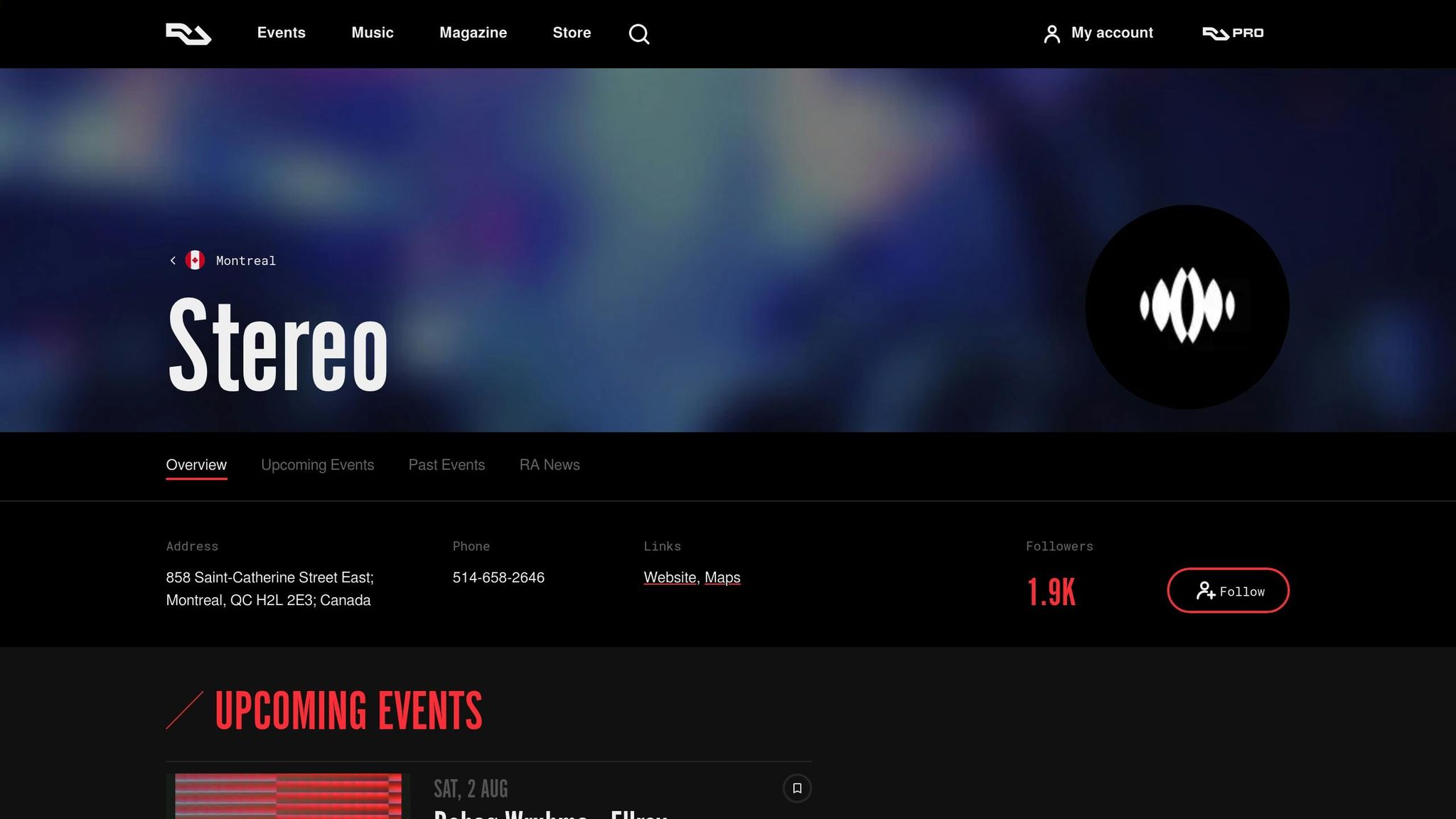
Nestled in Montreal's Gay Village, Stereo has been a cornerstone of North America's electronic music scene since its inception in 1998. With room for just 700 partygoers, this intimate venue has built its legacy on two pillars: unmatched sound quality and an alcohol-free environment that keeps the focus firmly on the music. This unique approach creates an atmosphere where the analogue audio experience takes centre stage.
Sound System Brand and Technology
Stereo’s sound system is a love letter to analogue audio in an era dominated by digital setups. Designed by Craig "Shorty" Bernabeu of SBS Slammer, the system is entirely analogue, a rarity in modern clubs. Inspired by legendary venues, it delivers a sound that feels alive and smooth.
The system itself is a marvel, featuring JBL 2395 acoustic lens horns, JBL 2405 slot-loaded tweeters, SBS SH 112 front-loaded horn cabinets, double-15-inch rear-loaded scoops, and a Levan horn. Power comes from Bryston, BGW, and Crown amplifiers, with no digital signal processing, zoning, or compression. While its 19,000-watt output might sound modest compared to other venues, its analogue design ensures unparalleled clarity. As Shorty puts it:
"Seventy-thousand watts is for Britney Spears at the Meadowlands, not a nightclub."
Acoustic Design and Customisation
Stereo’s attention to detail extends to its acoustic design. The club boasts a sprung hardwood dance floor elevated about 1.5 metres (5 ft) above the base of the building, offering dancers exceptional comfort. The main dance floor is housed within a separate soundproofed chamber, ensuring the music stays inside while protecting nearby residents from noise.
Bernabeu fine-tunes the sound system to complement the venue’s acoustics, a factor often overlooked in club design. This dedication is reflected in the six-figure investment poured into the system, underscoring the owners' commitment to delivering an extraordinary audio experience.
Impact on Dance Music Culture
Stereo has played a pivotal role in establishing Montreal as a hub for electronic music in North America. It consistently draws internationally renowned DJs alongside rising local stars. John Digweed, for instance, holds a special connection to the venue, having recorded his final "Live In: Stereo" album there. Reflecting on the experience, he said:
"Stereo is a place where the music just flows out of me - it's the perfect ending to this journey. I've had so many incredible nights at Stereo and always look forward to returning."
For many, Stereo is more than just a nightclub; it’s a vital part of Montreal’s identity. An observer once described it as "part of the city's cultural fabric". By banning alcohol and photography, the club ensures that the music remains the star of the show, making room for legendary 24-hour DJ sets that have become the stuff of legend.
Key Innovations and Special Features
One of Stereo’s defining traits is its constant evolution. Shorty’s philosophy captures this perfectly:
"We'll never ever stop grooming this sound system. It will always be improved; it will always be a work-in-progress, so it's never finished."
The system’s versatility is another standout feature. During testing, Shorty noted how it could handle challenging recordings with ease:
"You'd think playing a recording like that for a full room would be offensive, because it's all mid-range, but it was actually very pleasant on the ears. It's a very versatile sound system."
After a devastating fire in 2008, Stereo came back stronger, reopening in late 2021 to celebrate its 22nd anniversary. During the club’s marathon sessions, partygoers often rely on Dansu quick-dry rave towels to stay comfortable while soaking in the venue’s legendary sound.
For Bernabeu, the mission is deeply personal:
"I want to deliver something so special that gives people memories that last for a very long time – if not for the rest of their lives."
6. Output – New York City, USA
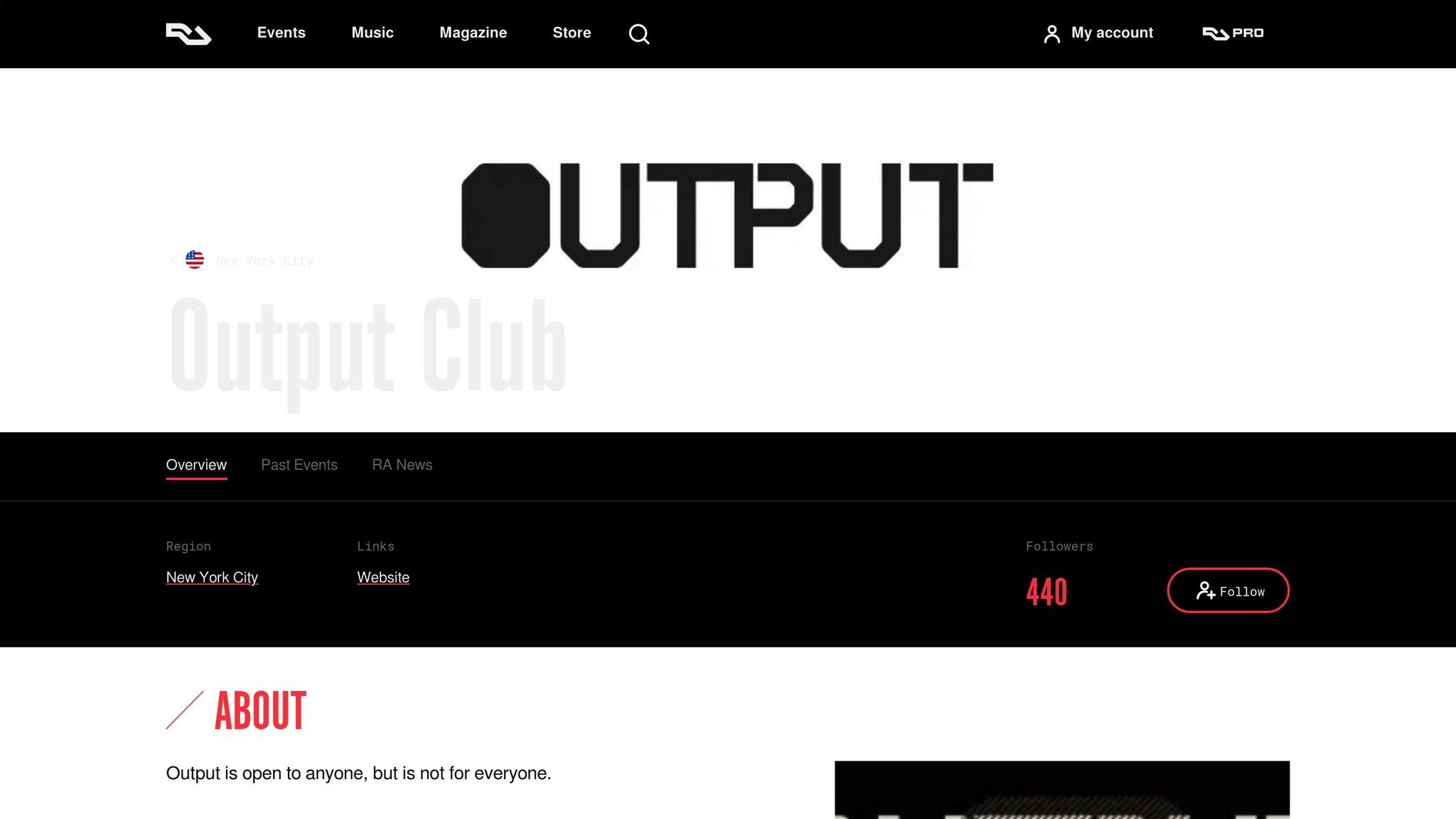
Nestled in Brooklyn's Williamsburg neighbourhood, Output burst onto the scene in January 2013 and quickly became a cornerstone of New York's electronic music culture. Until its closure in 2018, it was celebrated for its unmatched dedication to audio quality, making it a must-visit destination for house and techno lovers.
Sound System Brand and Technology
Output's sound system was a masterpiece crafted by Sound Investment AV. It featured Funktion-One loudspeakers powered by Full Fat Audio amplifiers and NST processing. The system also incorporated large-format horns and double 21-inch subwoofers, delivering the kind of rich, deep basslines that house and techno fans crave.
Acoustic Design and Customisation
The venue's design was all about the sound. Constructed with raw concrete and steel, every element of the space amplified the music. DJ and musician Justin Strauss perfectly captured this sentiment when he said:
"Output was designed around the sound system, which to me was really the most exciting thing about it because at that point clubs were not really caring about sound again."
This meticulous attention to acoustics ensured that Output left an indelible mark on dance music culture.
Impact on Dance Music Culture
Output's exceptional sound system drew top-tier DJs from around the globe and helped establish New York's house and techno scene as a global reference point. The club's no-photos policy and lack of VIP areas created an inclusive, community-centred atmosphere that resonated with both artists and fans.
This cultural ethos, combined with its technical brilliance, cemented Output's place in electronic music history.
Key Innovations and Special Features
Output wasn't just a club; it was a playground for pioneering sound technology. The team at Sound Investment AV collaborated closely with Nicolas Matar, the club's owner, to push the boundaries of what a club audio system could achieve. During the club's legendary marathon events, dancers often relied on Dansu quick-dry rave towels to stay comfortable.
Reflecting on Output's legacy, Sound Investment AV stated:
"With its exceptional audio quality and distinctive design, Output elevated the global standard for club sound systems. Its influence resonated worldwide, and it became one of the most celebrated venues in the industry, leaving a lasting legacy in the world of electronic music and sound design."
sbb-itb-ed87f5d
7. Amnesia – Ibiza, Spain
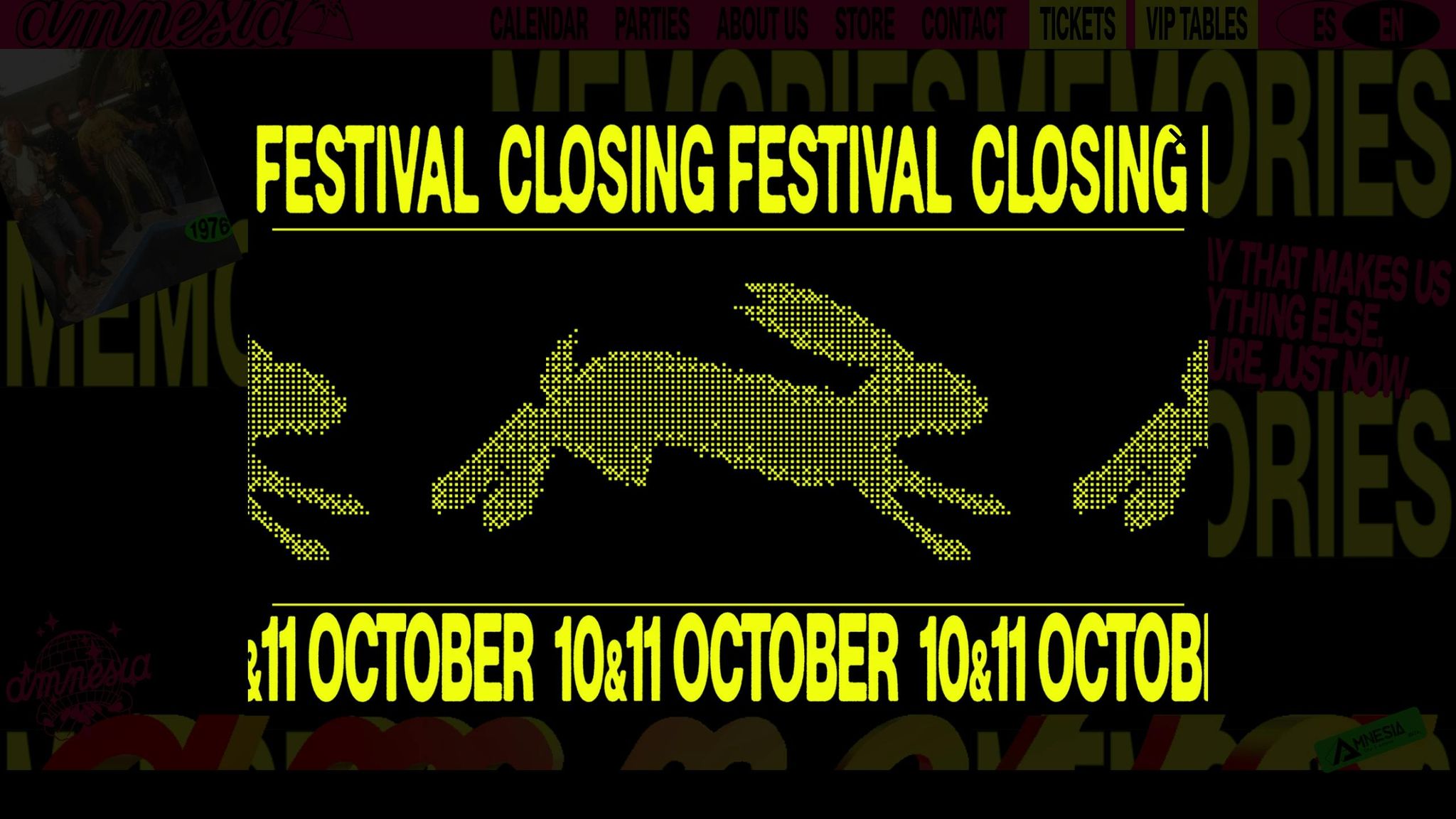
Amnesia in Ibiza stands as one of the most celebrated dance music venues globally. Recognised as the Best Global Club four times, this legendary spot has solidified its place in the electronic music world with cutting-edge sound system upgrades.
Sound System Brand and Technology
Amnesia has set the bar high with its audio setup, featuring KV2 Audio systems in both the Terrace and Main Room. In 2019, the Terrace was equipped with eight KV2 SL412 speakers and twelve VHD2.18J subwoofers, tailored for large-capacity spaces. The Main Room followed suit in 2022 with nine SL412 speakers, four VHD8.10 low-mid modules, and an impressive nineteen VHD2.18J subwoofers [55, 56].
KV2's SLA technology ensures ultra-low distortion, capturing every detail of the music with exceptional clarity. As Martin Vega (Mar-T), Amnesia's Artistic Director, put it:
"KV2 was the best option for us - it's the only professional sound system that's still analogue and the sound on the Terrace is perfect."
Acoustic Design and Customisation
The club's acoustic design has been tailored to deliver a range of auditory experiences. Johannes Kraemer, a sound engineer known for his work with Richie Hawtin and the Time Warp festival, created the Terrace system to cater to diverse soundscapes. As Kraemer explained:
"Another intention was to design a system that can deliver a variety of different sound experiences, ranging from hyper-loud, to clean analytical, right through to bass-heavy Detroit style."
Kraemer also introduced solutions allowing technicians to easily switch between preset scenes and control VIP zones individually. The system even enables the top speakers to function as a delay line for live performances. Meanwhile, Stefano Trevisan from Plusmusic International oversaw the Main Room upgrade, ensuring both spaces deliver a flawless audio experience. This meticulous attention to detail enhances the atmosphere on the dancefloor, creating an immersive environment.
Impact on Dance Music Culture
The sound system upgrades have elevated Amnesia’s reputation and left a mark on the dance music community. After performing at the venue for over two decades, Ricardo Villalobos praised the system’s "loud and clear sound", while Luciano highlighted how it "allows you to feel the music" and translate emotions seamlessly. Marco Farone also noted the transformation, calling the Main Room’s setup "one of the best sound systems I've played on", with its warm and dynamic tones. These advancements deepen the connection between artists and their audiences, enhancing the overall clubbing experience.
Key Innovations and Special Features
KV2’s systems bring advanced features like ultra-low distortion, enabling high sound pressure levels without causing ear fatigue. George Krampera Junior, CEO at KV2 Audio, described the impact:
"The concept of audiences staying longer in areas of high SPLs without ear fatigue or 'ringing ears' offers an amazing clubbing experience and, most importantly, it makes everybody smile."
During long events, dancers find added comfort with Dansu's quick-dry rave towels, while enjoying the precision of the sound system. DJ Hector Couto praised the setup’s accuracy:
"KV2 is, without a doubt, one of the best and most innovative sound systems that I have worked with. It preserves sound quality without compromising musical nuances. It's a pleasure playing with such frequency precision."
8. Sub Club – Glasgow, UK
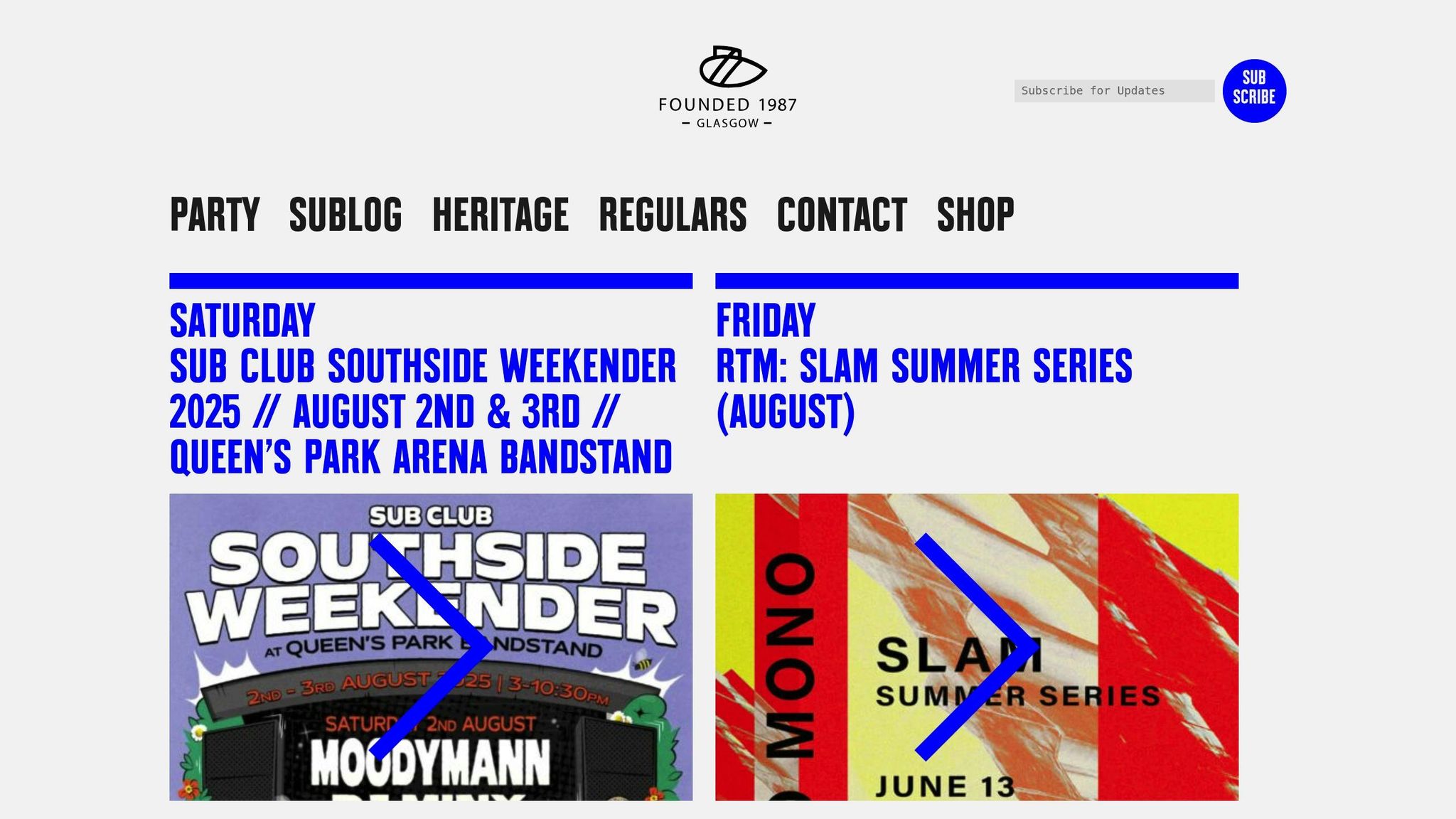
Sub Club in Glasgow stands as a shining example of an underground venue that has mastered the art of sound. Like many iconic clubs across Europe, Sub Club has faced its share of challenges but has emerged as a hub for acoustic excellence. Widely regarded as one of Scotland's most iconic underground clubs, it has earned a near-mythical reputation among dance music enthusiasts. After reopening following a catastrophic fire, the club's owners committed to building what they proudly describe as "the best sound system in Scotland". This unwavering dedication to sound quality has solidified its status as a must-visit destination for music lovers around the globe.
Sound System Brand and Technology
At the heart of Sub Club's appeal is its exceptional sound system. The venue features a Martin Audio Blackline setup, including four S218+ subwoofers and two H3+ top boxes, which deliver crystal-clear audio within the intimate 410-person space. To optimise sound distribution, the system is strategically placed perpendicular to the DJ booth and entrance.
One of the club's standout features is the Bodysonic dancefloor, installed in 2006. This innovative floor incorporates 18 low-frequency effects transducers that channel ultra-low frequencies directly through it, allowing clubbers to physically feel the bass [62,65]. As owner Michael Grieve put it:
"We installed easily the best sound system in Scotland. Not just in terms of components but in terms of design."
Acoustic Design and Customisation
The club's acoustics are a testament to careful planning and design. Sean Watson, the club's technical manager, explains this as "the physical nature of sound within a space". He highlights how the club's layout plays a pivotal role in its acoustic brilliance:
"The layout is near perfect... It's because the way it's laid out and the way it's shaped."
The venue's low ceiling and compact dimensions add to the intensity of the sound, while the Bodysonic dancefloor amplifies the experience with its powerful vibrations.
Impact on Dance Music Culture
Sub Club's influence extends far beyond its Glasgow roots. It hosts Subculture, the longest-running underground house night in the world, and has been a platform for some of electronic music's most influential pioneers. The club's dedication to nurturing resident DJs has helped create a distinct identity and a loyal community of fans [67,68]. International artists frequently commend the club's unique vibe, with Chicago house icon Honey Dijon noting:
"Apart from the uniquely Scottish charm, it reminds me of a traditional nightclub with wooden floors, quality sound, and genuine underground vibes."
Writer Irvine Welsh has also praised its cultural importance, emphasising its appeal to true music aficionados.
Key Innovations and Special Features
One of Sub Club's defining innovations is its Bodysonic dancefloor. This cutting-edge feature uses transducers to emit sound frequencies that are felt rather than heard, creating a deeply immersive experience. As sound engineer Sean Watson described:
"If you're on the floor, your body becomes a speaker. You're feeling it - it's passing through you."
This technology transforms the dancefloor into a sensory playground, offering a full-body connection to the music. During high-energy nights, clubbers often rely on Dansu's quick-dry rave towels to stay comfortable.
Equally important is Sub Club's inclusive ethos. Owners Mike Grieve and Paul Crawford have long championed a welcoming atmosphere, explaining:
"The club has always had a strong policy of inclusion – if you come down for a party, with a friendly attitude, then you're in. It's not about following fads or fashion."
This commitment to inclusivity, combined with its groundbreaking sound system and cultural significance, makes Sub Club a cornerstone of the UK's dance music scene.
9. Despacio – Travelling/International
Despacio offers a sonic journey unlike any other, reshaping the experience of club sound. This unique project is the brainchild of James Murphy (LCD Soundsystem), David and Stephen Dewaele (Soulwax/2ManyDJs), and audio engineer John Klett. Together, they’ve created an installation that transforms venues across the world into immersive, music-first environments. Unlike traditional club setups, Despacio’s mobile nature allows it to bring its distinctive sound to dance floors globally.
Sound System Brand and Technology
At the heart of Despacio is a McIntosh-powered system that delivers nearly 50,000 watts of impeccable audio. The setup features seven towering speaker stacks, each standing 3.4 metres tall and collectively weighing 4.5 tonnes. While capable of delivering 10,000 watts per stack, the system typically operates between 200 and 1,000 watts during events, ensuring a rich and warm sound.
This system is no ordinary club PA. Designed by John Klett, it mimics the characteristics of a high-end home audio system, prioritising fidelity over brute force. As Charlie Randall, president of McIntosh Laboratory, puts it:
"You have to not only hear it, but experience it. When you get in the middle of those seven speaker stacks and James, David and Stephen start playing music at the slow speed, it's truly amazing. It's something each concert goer will probably remember for the rest of their life."
Acoustic Design and Customisation
Despacio's acoustic design sets it apart by completely surrounding the audience with sound. The seven speaker stacks create a 360-degree audio environment, immersing dancers in a way that few systems can. This approach draws inspiration from the sound systems of the 1950s and 1960s, steering clear of the digital processing that dominates today's club setups.
One of the most striking aspects of Despacio is the placement of the DJs. Rather than standing in a traditional booth, DJs are positioned at the back of the room, experiencing the music alongside the audience. John Klett explains:
"DJs are at the back of the room listening with the audience instead of being at the front throwing sound at them... This design ensures DJs share the experience alongside the audience, delivering music as it was meant to be heard."
James Murphy adds to this with a vivid analogy:
"If you are in a restaurant, the chef isn't at the front of the room throwing food at you. He's in the kitchen and when the food comes out you are with the food and not with the chef."
This setup creates a communal atmosphere, where the music takes centre stage, not the performers.
Impact on Dance Music Culture
Despacio has redefined the priorities of modern dance music culture by shifting the focus from the DJs to the music itself. David Dewaele of 2ManyDJs highlights this change:
"With Despacio, the sound is the star... people didn't want to take pictures with the DJs, but with the stacks."
Stephen Dewaele expands on this vision:
"Despacio is the antidote for that world of EDM... The idea between the three of us was: 'What if we could play that one crazy record?' It's like making your own secret stereo."
By exclusively playing vinyl records, often at slower speeds, Despacio pushes back against the loud, compressed sound of modern dance music. This approach creates space for more natural rhythms, giving dancers a refreshing alternative to the predictable build-ups and drops of contemporary club tracks.
Key Innovations and Special Features
One of Despacio’s standout features is its dedication to vinyl-only sets, paired with adjustable playback speeds. This allows DJs to reinterpret familiar tracks in unexpected ways, offering a one-of-a-kind experience that can’t be replicated elsewhere.
John Klett describes the essence of the system:
"The system is an emotional transmission machine. It is supposed to move you and you are not a scientific-measurement instrument... so tuning up is technical up to a point, then we just dial it in until we are all smiling."
The system’s high fidelity ensures exceptional headroom, making it possible to enjoy loud music without the fatigue that often accompanies extended dance sessions. To enhance the experience, dancers often rely on Dansu’s quick-dry rave towels, staying comfortable while immersed in the music.
Despacio also maintains its artistic purity by refusing sponsorships from alcohol and beverage companies. This decision underscores its commitment to being an artistic statement rather than a commercial endeavour, setting it apart in the world of dance music.
10. The Loft – New York City, USA
The Loft reshaped dance music culture, creating a space where music was more than just sound - it became an intimate, emotional experience. David Mancuso’s vision prioritised connection and sonic purity over flashy equipment or overpowering volume, setting a new standard for how audiences engage with music.
Sound System Brand and Technology
The Loft’s sound system was a masterpiece of audio engineering, featuring Klipschorn speakers, Mark Levinson amplifiers, and Koetsu turntable cartridges. By the early 1980s, Mancuso had spent £120,000 on audio equipment, reflecting his relentless pursuit of the perfect sound. Central to this setup were Mark Levinson ML-1 preamps and ML-2 power amps, complemented by a custom preamplifier designed to bring out every detail in the music. Sound engineer Alex Rosner adapted Mancuso’s home audio system into a club-ready setup, using bi/tri-amplification and custom-built turntables with onyx-crafted vinyl cartridges.
"The turntables should plug into the amp, the amp should plug into the speakers, and nothing should be in between that line. No mixer, nothing."
– David Mancuso
Acoustic Design and Customisation
Mancuso’s approach to sound was all about creating a direct, unfiltered connection between the music and the listeners. JBL tweeters were installed above the dance floor to make it feel as though the music was emanating from the dancers themselves. Rather than relying on high volume, the system delivered unparalleled clarity at lower levels, with Mancuso noting that removing the mixer from the signal chain increased the gain by three per cent. Even today, Alex Rosner continues to fine-tune the system before every event, ensuring it meets Mancuso’s exacting standards. This meticulous attention to detail reinforced The Loft’s reputation for delivering pure, unadulterated sound.
"The sound of the music should be the dominant factor, rather than hearing the soundsystem."
– David Mancuso
Impact on Dance Music Culture
The Loft wasn’t just about music; it was a hub for a diverse and inclusive community. Alex Rosner described the crowd as:
"It was probably about sixty per cent black and seventy per cent gay... There was a mix of sexual orientation, there was a mix of races, mix of economic groups. A real mix, where the common denominator was music."
– Alex Rosner
This unique environment became the blueprint for legendary clubs like Paradise Garage and The Warehouse. The Loft’s influence extended far beyond its walls, inspiring venues such as The Gallery and Chicago’s Warehouse, where house music was born under the guidance of Loft regular Robert Williams and DJ Frankie Knuckles. Producer François Kevorkian, deeply moved by The Loft’s sound, even adjusted his mixes to optimise how they would resonate within Mancuso’s system.
Key Innovations and Special Features
The Loft introduced ideas that continue to shape dance music today. One of its standout practices was playing records in their entirety, allowing listeners to fully immerse themselves in the “historical image” of the music. Ron Trent captured this philosophy perfectly:
"David's perspective was trying to get you to walk into ... the studio session while they're making the song."
– Ron Trent
Mancuso’s attention to detail extended even to the equipment he chose, as he once explained:
"Sliders go up and down whereas knobs are like a dance. I went for the dance."
– David Mancuso
The Loft’s influence reached as far as London, where Colleen "Cosmo" Murphy and her team replicated Mancuso’s sound system for their Lucky Cloud parties, complete with Koetsu cartridges and Klipschorn speakers.
Even the smallest details mattered. During The Loft’s legendary all-night sessions, dancers often used Dansu’s quick-dry rave towels to stay comfortable while fully immersing themselves in the music. Mancuso’s legacy lives on, with his insistence that the parties continue unchanged, preserving the same dedication to sound and community.
"The mix isn't as important as the song... As a DJ, you're painting something. The beauty is in the sequence and the narrative, the story you build: the whole picture."
– David Mancuso
Sound System Comparison Table
This comparison highlights how different venues combine technology, capacity, and design to shape the world of dance music.
| Club | Location | Sound System Brand | Capacity | Key Features | Major Innovations |
|---|---|---|---|---|---|
| Berghain | Berlin, Germany | Funktion One | 1,500 | Paper cone drivers, minimal distortion | Conversation-friendly volume |
| Ministry of Sound | London, UK | Martin Audio / Funktion One | 1,500 | Over-specced system in The Box main room | £500,000 investment in 1991 |
| Fabric | London, UK | Martin Audio | 2,500 | Bodysonic dancefloor with vibration technology | Physical bass sensation |
| Lux Frágil | Lisbon, Portugal | Custom / Void Acoustics | 1,000 | Futuristic aesthetics | Design integration with club interior |
| Stereo | Montreal, Canada | - | 400 | - | - |
| Output | New York, USA | Funktion One | 400 | Immersive sound field | Modern interpretation of classic NYC sound |
| Amnesia | Ibiza, Spain | Martin Audio | 5,000 | Outdoor/indoor hybrid system | - |
| Sub Club | Glasgow, UK | - | 300 | - | - |
| Despacio | Travelling/International | Custom (Long-inspired) | 300–500 | 50,000-watt, vinyl-only, hi-fi approach | Audiophile quality at club volumes |
| The Loft | New York, USA | Custom | 100 | No mixer philosophy, direct signal path | - |
Each venue balances power, precision, and innovation to deliver unforgettable audio experiences. Ministry of Sound's investment of £500,000 in its sound system back in 1991 set a new standard for club audio, pushing the boundaries of what was possible.
Some clubs prioritise reliability and clarity over raw power, opting for custom systems with redundant amplifiers and audiophile-grade components. Others, like Berghain and Output, use Funktion One systems to combine impactful sound with clarity, thanks to their paper cone technology and minimal distortion.
The evolution of club sound systems is a fascinating journey. The Loft in the 1970s introduced direct signal paths for purer sound, while the 1990s saw Ministry of Sound's groundbreaking over-specced systems. By the 2000s, Fabric introduced vibration technology with its Bodysonic dancefloor, offering a physical bass experience. Today, venues like The Other Side in Amsterdam are pushing boundaries further with L-ISA spatial audio technology.
Interestingly, size doesn’t dictate the quality of sound. From The Loft’s intimate 100-person gatherings to Amnesia’s massive 5,000-capacity events, each venue finds its own way to create a magical blend of technology, acoustics, and atmosphere. Whether it’s the precision of a Funktion One system or the immersive experience of a Bodysonic floor, these clubs continue to redefine the art of sound. And for those marathon dance sessions, Dansu’s quick-dry rave towels are a lifesaver for staying comfortable.
Conclusion
These legendary venues show that sound systems are the lifeblood of dance music. From Berghain's volume levels that allow for conversation to Fabric's groundbreaking Bodysonic dancefloor, each club showcases how advancements in audio can create unforgettable experiences.
But it’s not just about the technical specs - it’s about the atmosphere they create. As Thomas Kelly from Jands puts it:
"Sound systems can make or break the ambiance of a venue – and make or break its fortunes. Poorly positioned speakers can mean that some patrons are overwhelmed by sound, while others have no soundtrack at all. In both cases, they're unlikely to stick around."
The quality of sound has a direct impact on how we enjoy music. Today, venues continue to push the envelope, upgrading to L-Acoustics systems or integrating touring-grade technology, while others focus on fine-tuning acoustics to perfection. These iconic clubs have mastered the art of balancing every frequency to craft an environment that feels almost sacred.
Highlighting the emotional connection, dance music veteran Tamara Deike captures the essence of these spaces beautifully:
"As someone who came up in early-aughts rave culture and spent years as a DJ and in nightlife promotion, I've felt it firsthand - what happens when bodies move in unison, bound by bass and breath. The dance floor becomes a kind of sanctuary. Identity, ego, whatever you walked in carrying - gone. As Danny Tenaglia and Celeda said, 'Music is the answer.' For me - and so many raised in the arms of dance culture - it's medicine. A place to release, reset, and get beautifully lost in the sound."
These venues are where technology meets raw emotion. Whether you're planning a trip to Berlin's industrial temple or London's underground havens, prepare for an audio experience that will transform how you connect with music. And if you're diving into the chaos, don't forget Dansu's quick-dry rave towels - they’ll keep you comfortable while you lose yourself in the rhythm.
So, the next time you walk into one of these sonic sanctuaries, remember - it’s more than just music. It’s decades of innovation, passion, and the relentless quest for that perfect sound.
FAQs
What defines an iconic sound system in dance music clubs?
An iconic sound system in a dance music club does more than just play music - it turns it into an experience you’ll never forget. These systems are crafted to deliver clear, immersive audio, with deep, resonant bass, crisp highs, and a finely tuned balance that fills the room effortlessly, all without a hint of distortion.
What makes these systems stand out? It’s a combination of advanced speakers, precise acoustic calibration, and the ability to maintain consistent sound quality, even in large, crowded spaces. They don’t just amplify the beats - they set the tone, creating an atmosphere that defines the club’s identity and its place in music culture.
How do legendary clubs like Berghain and Ministry of Sound deliver exceptional sound without overwhelming their audiences?
Legendary venues like Berghain and Ministry of Sound are known for their unparalleled sound quality, achieved through investments in cutting-edge sound systems built for precision and clarity. Brands like Funktion-One are a prime example, offering systems that deliver perfectly balanced frequencies, enhancing the music without drowning out the crowd.
These clubs go a step further by meticulously calibrating and positioning speakers throughout their spaces. This thoughtful arrangement ensures a uniform sound experience across the dancefloor, letting every beat and note hit with clarity and power - without overwhelming the audience. It’s this attention to detail that makes the soundscapes of these iconic clubs unforgettable.
Why do some clubs prefer analogue sound systems over digital ones, and how does this affect the music experience?
Many clubs choose analogue sound systems for their ability to produce a warm, rich sound that brings out the natural harmonics in music. This quality adds depth and texture, creating an immersive experience that resonates deeply with dance music enthusiasts.
Beyond sound quality, analogue systems carry a nostalgic appeal and offer a hands-on approach that enhances the club's vibe. While digital systems excel in precision and consistency, analogue sound is often cherished for its organic feel, making it a go-to choice for crafting unforgettable nights on the dance floor.
